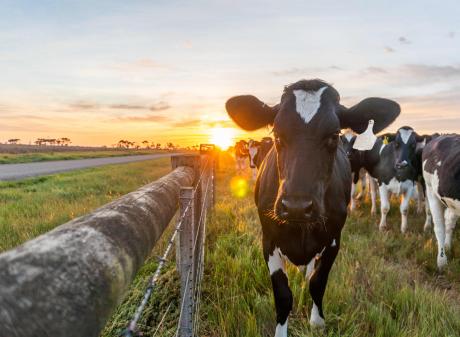
But to make it happen, beef farmers would have to switch from rearing traditional breeds and consumers would need to embrace the taste of yellow fat.
Otago Fresh Milk owner Shelli Mears milks about 30 cows on 24ha near Palmerston.
All of the calves born on the farm are reared because the killing of bobby calves did not sit comfortably with her and her husband Steve.
"They all get a life — a productive life," she said.
Nearly 4million calves were born on dairy farms across New Zealand each spring,

She wanted those dairy bull calves to be reared by farmers who ran traditional beef breeds, such as Angus and Hereford.
Those farmers would need to run only dairy-beef due to limitations on resources.
"There is a limited amount of land in New Zealand, you can’t rear everything or we will run out of space and feed."
Their 2-year-old bull Rojo — a quarter red factor Friesian and the rest Jersey — would be killed for beef in about two months.
"He’s looking good — we are going to have good prime meat."
When asked what is the difference in killing an animal on day one compared to day 730, she replied: "At least he’s had a life where he’s been loved and cared for, been well fed and had all his needs met until such time he’s useful."
A bobby calf was of little value to anyone because veal was not popular in New Zealand.
"There’s almost more processing cost than there is product."

Challenges to stopping bobby calves being killed would be convincing beef farmers to switch from traditional breeds to dairy-beef.
As dairy cattle were smaller than traditional beef breeds, meat yields would be lighter, resulting in smaller profit margins.
Meatworks paid a premium for some traditional beef breeds, such as Angus and did not for dairy-beef.
Another challenge was a farmer needing a "huge mindset change" from buying 6-month-old beef weaners to finish, to rearing 4-day-old dairy calves instead.
Most farmers lacked the facilities to rear calves, she said.
She acknowledged it was much easier for her to rear calves because there were fewer of them on a small farm.
Rearing calves on a bigger operation would be much more difficult, she said.
"We are not holier-than-thou, we’ve been sharemilkers and had to send bobby calves on the truck year after year."
There were no easy solutions to ending the culling of bobby calves in New Zealand. It would require major changes across the agricultural sector, she said.
Another challenge was a lot of the dairy-beef from the national herd had yellow fat.
The public held a perception yellow fat tasted bad, which was wrong.
"Jersey meat and yellow fat tastes brilliant — it’s delicious and has a flavour, whereas white fat doesn’t have flavour."
A solution for the issue could be for a major retailer, such as McDonald’s, to sell products including 100% crossbred dairy meat and promote it as an ethical food choice.
A commercial pricing signal would be needed to bring change, she said.
"That comes down to consumer demand."
If enough customers told fast-food giants to use dairy-beef to stop bobby calves being killed, it could create a market.
Federated Farmers Otago president Mark Patterson, of Lawrence, said he would not support the call in a mandatory sense.
"I agree that this is an opportunity that requires much more focus. At present there is a lack of labour on dairy farms which would make this a challenge.
"Both the dairy and meat companies could do more to facilitate co-ordination of the supply chain to develop end-to-end contracting systems to attract more specialist calf rearers by ensuring financial security."
Beef breeding cows would always have a place as they played a vital role on hill country in cleaning up rough forage for breeding ewes and finishing stock.
"Traditional beef breeders have done a fantastic job focusing on carcass and meat quality traits which are starting to attract meaningful premiums to satisfy demand from high-end markets."
The encroachment of trees was impacting land traditionally grazed by beef cows so there would naturally be more demand for dairy-beef to fill the gap for beef finishers.
Any marketing initiatives which could assist driving specific demand for dairy-beef would be positive as long as it did not risk undermining existing programmes, he said.
DairyNZ systems and competitiveness strategy and investment leader Bruce Thorrold said the dairy sector supports all the animals born on farms, having a productive life. "Therefore greater rearing of replacement dairy calves into the beef supply chain is something we encourage all dairy and beef farmers to consider for their farm systems."
Dr Thorrold said 72% of dairy farmers already used beef genetics to improve the value and performance of these calves.
In New Zealand, about 30% of beef finishing animals were born in the dairy sector. About 60% of the beef cull was also of dairy origin.
Beef + Lamb New Zealand farming excellence general manager Dan Brier said dairy-beef was one of its priorities.
Its Dairy-Beef Progeny Test calculates the additional value which could be added by using high genetic-merit beef bulls versus the unrecorded bulls traditionally used as "follow-up bulls" in many New Zealand dairy systems.
"We actively work with our dairy levy payers and the wider industry to ensure as many non-replacement dairy calves enter value chains – for example, we look to identify and promote opportunities for dairy-beef products, such as rose veal."
B+LNZ worked on improving market access for manufacturing beef through trade negotiations and adding value to dairy-beef through the Taste Pure Nature origin brand.
Much of the hill country which traditional cattle were reared on was not suitable for dairy-cross animals due to the poorer quality feed and tougher environmental conditions. Beef animals in sheep and beef systems play an important role in maintaining feed quality for other classes of stock including sheep and young growing cattle.
"They’re part of complex biological systems and removing beef cattle from that system will have other consequences in the farm system."
SHAWN.MCAVINUE@alliedpress.co.nz














